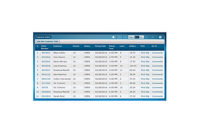Supply chain management in the meat product sector is very challenging. The procurement process is inseparable from the breeding and raising of animals, and lead times vary from about 18 weeks to 3 years. The cost of the meat as a raw material is the main cost element of the final product. That means careful long-term planning is essential to ensure the best possible balance between the supply of meat, production and sales. Because the final product’s shelf life is short, accurate day-by-day forecasts are essential in guiding production, ensuring high availability and minimizing waste.
Before Atria, a Finland-based supplier of meat products for grocery retail and foodservice sectors, started working with RELEX, it had custom-built systems for both short and long-term forecasting and planning.
The main forecasting-related challenges came from situations like customer-led promotions, big retailers’ buying decisions, product launches and seasonal demand forecasting. High-level planning was also complicated by foodservice customers that sometimes generated very high, often seasonally-related demand peaks.
Having looked at several options, Atria chose RELEX, an Atlanta-based provider of forecasting and replenishment software solutions.
“RELEX’s forecasting solution met our needs precisely,” says Jaakko Takala, Atria’s director of supply chain management. “We were especially pleased that the system offered a complete suite of tools with well thought out, well-tested and intuitive workflows for both forecasting the base demand and managing special situations. It was clear that with the help of RELEX, we could improve our planning accuracy while also streamlining our processes.”
Using RELEX’s statistical forecasting models, Atria has been able to bring forecasting down to a customer-chain level, all while taking into account variations in delivery volumes on different days of the week. The forecasts are continually calculated on a customer chain product level looking 18 months ahead. By consolidating the forecasts at a planning-group level, it is possible to produce data for long-term raw materials planning.
“Even the base demand forecasts produced by the system are more accurate than those that can be produced manually,” adds Takala.
The information about Atria’s customers’ planned campaigns and assortment was loaded directly into the system using an automatic data transfer interface.
“In addition to a planning tool, by opting for RELEX we also got a data warehouse that makes it easy for us to analyze customers’ past promotions and their impact on sales,” says Takala. “And, that gives us information that’s invaluable for planning future campaigns. When managing seasons, having access to and being able to analyze information about customer pre-orders and the assortment at individual stores is extremely important.”
As a part of the implementation project, RELEX and Atria’s existing enterprise resource planning (ERP) system, Infor M3, New York, was integrated. After the technical implementation was carried out, the planning process moved over to the RELEX system one customer group at a time.
“The implementation and integration were no big deal,” says Takala. “Personally, given my previous experience of IT projects, I was even a little surprised at how well everything went.”
Other benefits achieved:
- Forecasts are more consistent. Previously, occasional large errors in forecasts had caused problems in production planning.
- With the help of statistical forecasting models, the forecasting process has become more efficient and allows better support for the planning of customer-specific campaigns, the management of customer chains assortment decisions and planning the seasonal sales.
- Using the system, one can easily analyze the impact promotions and assortment decisions have on demand.
- Both short-term and long-term planning are based on the same forecasts and carried out in the same system.
- Using statistical forecasting frees up time for planning for special situations.
Atria’s main aim was to improve its forecast accuracy. That goal has been achieved with accuracy increasing by over 6 percentage points; the volume-weighted forecast accuracy on a weekly level is over 90%.
In conjunction with the introduction of RELEX systems, Atria’s forecasting has been centralized to a skilled planning team. As a result, the process has evolved and become easier to manage and develop further.
“Accurate forecasts on a customer-chain level will allow us to assess our performance against sales targets more quickly and to target corrective measures more effectively,” says Teemu Pitkänen, sales director at Atria.
“It was clear that with the help of RELEX, we could improve our planning accuracy while also streamlining our processes,” adds Takala.



